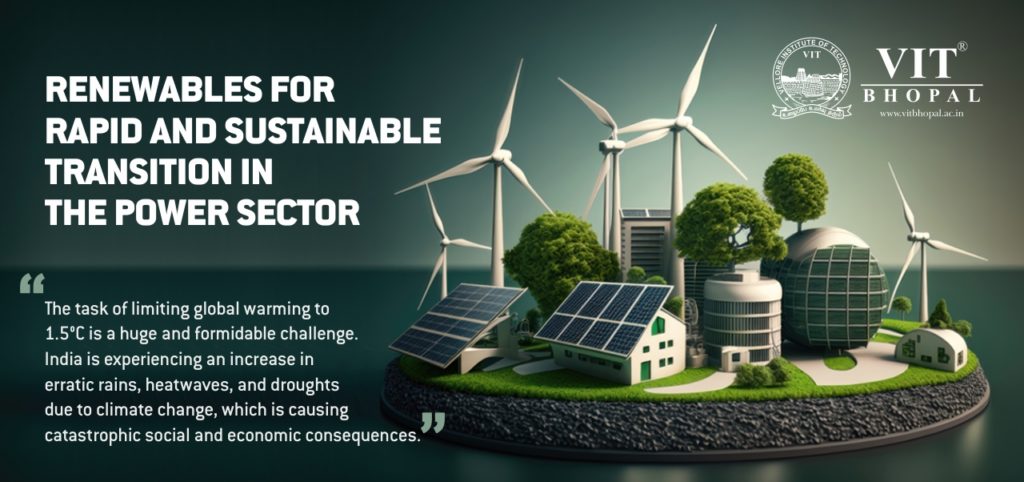Renewables for Rapid and Sustainable Transition in the Power Sector

The task of limiting global warming to 1.5°C is a huge and formidable challenge. India is experiencing an increase in erratic rains, heatwaves, and droughts due to climate change [1], which is causing catastrophic social and economic consequences. In India, the heavy dependence on low-quality coal and the operation of extremely inefficient power plants have given rise to greenhouse gas pollution while compounding various environmental concerns. The rapid transition towards renewable energy, particularly in the power sector, is the way forward to meet the Paris Agreement and achieve the UN Sustainable Development Goals [2], [3].
India has shown significant expansion in renewable capacity installations, especially solar and wind, over the last few years. To put this in context, the total renewable energy generation capacity in India has reached 152.90 GW as of February 2022, 50.78 GW from solar energy, 40.13 GW from wind energy, 10.63 GW from bio-energy, and 46.52 GW and 4.84 GW from large and small hydropower respectively [4]. However, the contribution of renewable energy in electricity generation varies substantially across Indian states. For instance, in states like Tamil Nadu, Rajasthan, Kerala, Punjab, Andhra Pradesh, Gujarat, Madhya Pradesh, Telangana, Karnataka, and Maharashtra, the electricity generation from renewables exceeds the national average of 8.2% by a substantial margin, whereas other Indian states are lagging in power generation capacity and production [5].
A recently published research article by Ashish et al. [6] in Nature Communications answered two critical questions: 1) Is an energy system powered entirely by renewable energy technically feasible in India and will it be the low expensive option in 2050, 2) How much and what will be the requirements for state and national production capacity, storage and flexibility during the transition? The power transition to 100% renewable energy by 2050 is crucial for India’s sustainable energy transition.
The study explores the power transition pathway in different states of India by incorporating several power generation alternatives, storage technologies, and interstate transmission to effectively fulfill hourly electricity demands over a complete year. Employing the LUT Energy System Transition Model tool [7], [8] from Lappeenranta University of Technology (LUT), the study formulates scenarios for India’s journey towards achieving a 100% renewable and sustainable energy resources.
The research provides some notable findings. Ashish et al. [6] find that integrating large shares of renewables for electricity generation by 2050 could be less expensive and eliminate coal-dominated systems. The reason behind this approach lies in establishing a power generation system primarily reliant on hydropower, wind energy, and solar photovoltaic. To ensure the system’s flexibility and stability, supplementary power will be derived from batteries and engines fueled by synthetic fuels. The findings also indicate zero greenhouse gas emissions in the power sector by 2050, compared to current national levels of around 1.2 GtCO2eq in 2020. Interestingly, the renewable transition route could reduce power transformation losses from 57% in 2020 to 9.3% in 2050. Furthermore, the levelised cost of electricity of the system could reduce from 69.5 $/MWh in 2020 to 37.2 $/MWh by 2050.

Credit: Pixabay Image
The study has a few limitations that could be explored in future studies. First, this research does not consider electrification in other power sectors such as transportation, heating/cooling and industry. This may result in a further rise in power demand throughout the transition. Second, the water footprint of renewable power generation is not adjusted for in this study. The use of water for cooling in coal-fired power plants is an issue. It is estimated that by the end of 2030, two-thirds of India’s power plants will face an acute water crisis. [9]. Therefore, a more solicitous evaluation of electricity-based water consumption would add another dimension to the debate over the sustainability of renewable-based power systems. Third, the model optimises potential capacities for wind energy and solar photovoltaic based on specific capacity densities, cost considerations, and land use limitations, it also does not determine resource locations that might preclude development in some of the suggested locations due to social constraints.
Despite these limitations, the research findings instill optimism by suggesting that the ambitious goals outlined in the Paris Agreement to restrict temperature rise to 1.5°C are within reach if large shares of clean, renewable energy can be integrated nationwide. Therefore, to meet this ambitious target, more efforts are needed to expand the renewable capacity in some states and the policies should be in line with the central government.
REFERENCES
- “IPCC. Climate Change: The Physical Science Basis. Contribution of Working Group I to the Sixth Assessment Report of the Intergovernmental Panel on Climate Change,” 2021.
- D. L. McCollum et al., “Energy investment needs for fulfilling the Paris Agreement and achieving the Sustainable Development Goals,” Nat. Energy, vol. 3, no. 7, pp. 589–599, 2018, doi: 10.1038/s41560-018-0179-z.
- R. Sharma et al., “Who is willing to pay for solar lamps in rural India? A longitudinal study,” Renew. Sustain. Energy Rev., vol. 140, no. January, p. 110734, 2021, doi: 10.1016/j.rser.2021.110734.
- “[PIB] – Press Information Bureau. MNRE- Government lays Roadmap for transition to Green Energy,” 2022. [Online]. Available: https://pib.gov.in/PressReleaseIframePage.aspx?PRID=1809372.
- IEA and NITI Aayog, “Renewables Integration in India,” Int. Energy Agency, 2021, [Online]. Available: https://iea.blob.core.windows.net/assets/7b6bf9e6-4d69-466c-8069-bdd26b3e9ed1/RenewablesIntegrationinIndia2021.pdf.
- A. Gulagi, M. Ram, D. Bogdanov, S. Sarin, and T. N. O. Mensah, “The role of renewables for rapid transitioning of the power sector across states in India,” Nat. Commun., vol. accepted, 2022, doi: 10.1038/s41467-022-33048-8.
- D. Bogdanov, A. Gulagi, M. Fasihi, and C. Breyer, “Full energy sector transition towards 100% renewable energy supply: Integrating power, heat, transport and industry sectors including desalination,” Appl. Energy, vol. 283, p. 116273, 2021, doi: 10.1016/j.apenergy.2020.116273.
- D. Bogdanov et al., “Radical transformation pathway towards sustainable electricity via evolutionary steps,” Nat. Commun., vol. 10, no. 1, pp. 1–16, 2019, doi: 10.1038/s41467-019-08855-1.
- S. Gajardo, D., Goyal, A., Kuzma, S. & Goswami, “How Water Challenges Threaten India’s Energy Security,” 2021, [Online]. Available: https://www.wri.org/%0Ainsights/water-challenges-energy-sector-india.

Dr. Rohit Sharma.
Mechanical Engineering.
VIT Bhopal University.
Dr. Rohit Sharma is currently serving as an Assistant Professor and Program Chair-Mechanical at VIT Bhopal University, India. He earned his Ph.D. from Politecnico di Milano (POLIMI), Italy in Energy and Nuclear Science & Technology in 2017. His research focused on the near-field region of turbulent swirling jets in the combustion & propulsion laboratory. Notably, Dr. Sharma received an esteemed Erasmus Mundus fellowship sponsored by the European Commission in 2013 to pursue his Ph.D. Prior to his doctorate, Dr. Sharma earned an M.Tech in Thermal Engineering from NIT Warangal in 2013 and a B.E. in Mechanical Engineering from LNCT Bhopal in 2010. Over the years, he has amassed extensive experience in the field of research and academia. For three years, he worked as a Senior Project Research Scientist at IIT Bombay. He also served as an Assistant Professor at NIT Jalandhar for some time and gained invaluable industrial experience as a Graduate Engineer Trainee at Vardhman Yarns for one year.
Dr. Sharma has an impressive record of 18 publications in esteemed journals and conferences and has been honored with best research paper and poster awards. As a core team member, he actively participated in the student solar ambassador workshop organized under the SoULS project at IIT Bombay, which achieved the Guinness World Record on 2nd October 2018 for lighting the most LED lights based on solar energy. He received the SERB-DST International travel grant in 2022 in the Young Scientist category to present his research work. His diverse research interests encompass Experimental Fluid Dynamics, Optical Diagnostics, Flow Visualization, Internal Combustion Engines, Proper Orthogonal Decomposition, Predictive Modelling, Rural Electrification, and Off-grid Solar Energy.


